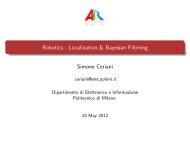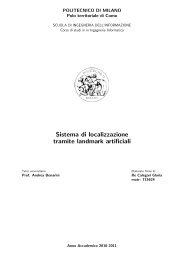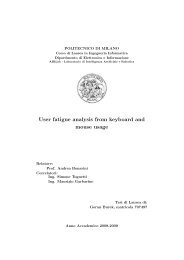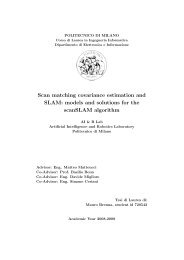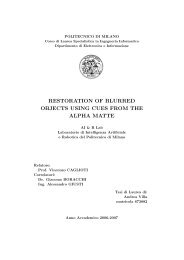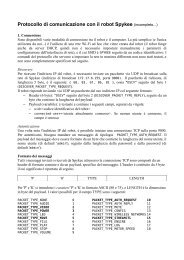Submitted version of the thesis - Airlab, the Artificial Intelligence ...
Submitted version of the thesis - Airlab, the Artificial Intelligence ...
Submitted version of the thesis - Airlab, the Artificial Intelligence ...
Create successful ePaper yourself
Turn your PDF publications into a flip-book with our unique Google optimized e-Paper software.
2.4. Games and Interaction 17<br />
We introduce now some <strong>of</strong> <strong>the</strong> robots developed in <strong>the</strong> past, related to<br />
<strong>the</strong> human robot interaction and games.<br />
Kismet(Figure2.8(a))isarobotmadein<strong>the</strong>late1990s at Massachusetts<br />
Institute <strong>of</strong> Technology with auditory, visual and expressive systems intended<br />
to participate in human social interaction and to demonstrate simulated<br />
human emotion and appearance. This project focuses not on robotrobot<br />
interactions, but ra<strong>the</strong>r on <strong>the</strong> construction <strong>of</strong> robots that engage<br />
in meaningful social exchanges with humans. By doing so, it is possible<br />
to have a socially sophisticated human assist <strong>the</strong> robot in acquiring more<br />
sophisticated communication skills and helping it to learn <strong>the</strong> meaning <strong>of</strong><br />
<strong>the</strong>se social exchanges.<br />
A Furby (Figure 2.8(b)) was a popular electronic robotic toy resembling<br />
a hamster/owl-like creature which went through in 1998. Furbies were <strong>the</strong><br />
first successful attempt to produce and sell a domestically-aimed robot. A<br />
newly purchased Furby starts out speaking entirely Furbish, <strong>the</strong> unique language<br />
that all Furbies use, but are programmed to speak less Furbish as<br />
<strong>the</strong>y gradually start using English. English is learned automatically, and<br />
no matter what culture <strong>the</strong>y are nurtured in, <strong>the</strong>y learn English. In 2005,<br />
new Furbies were released, with voice-recognition and more complex facial<br />
movements, and many o<strong>the</strong>r changes and improvements.<br />
AIBO (<strong>Artificial</strong> <strong>Intelligence</strong> Robot) (Figure 2.8(c)) was one <strong>of</strong> several<br />
types <strong>of</strong> robotic pets designed and manufactured by Sony. There have been<br />
several different models since <strong>the</strong>ir introduction on May 11, 1999. AIBO is<br />
able to walk, ”see” its environment via camera and recognize spoken commands<br />
in Spanish and English. AIBO robotic pets are considered to be<br />
autonomous robots since <strong>the</strong>y are able to learn and mature based on external<br />
stimuli from <strong>the</strong>ir owner, <strong>the</strong>ir environment and from o<strong>the</strong>r AIBOs.<br />
The AIBO has seen use as an inexpensive platform for artificial intelligence<br />
research, becauseit integrates a computer, vision system, and articulators in<br />
a package vastly cheaper than conventional research robots. The RoboCup<br />
autonomous soccer competition had a ”RoboCup Four-Legged Robot Soccer<br />
League” in which numerous institutions from around <strong>the</strong> world would<br />
participated. Competitors would program a team <strong>of</strong> AIBO robots to play<br />
games <strong>of</strong> autonomous robot soccer against o<strong>the</strong>r competing teams.<br />
ThedevelopmentsinRobocupleadtoimprovementsin<strong>the</strong>mobilerobots.




